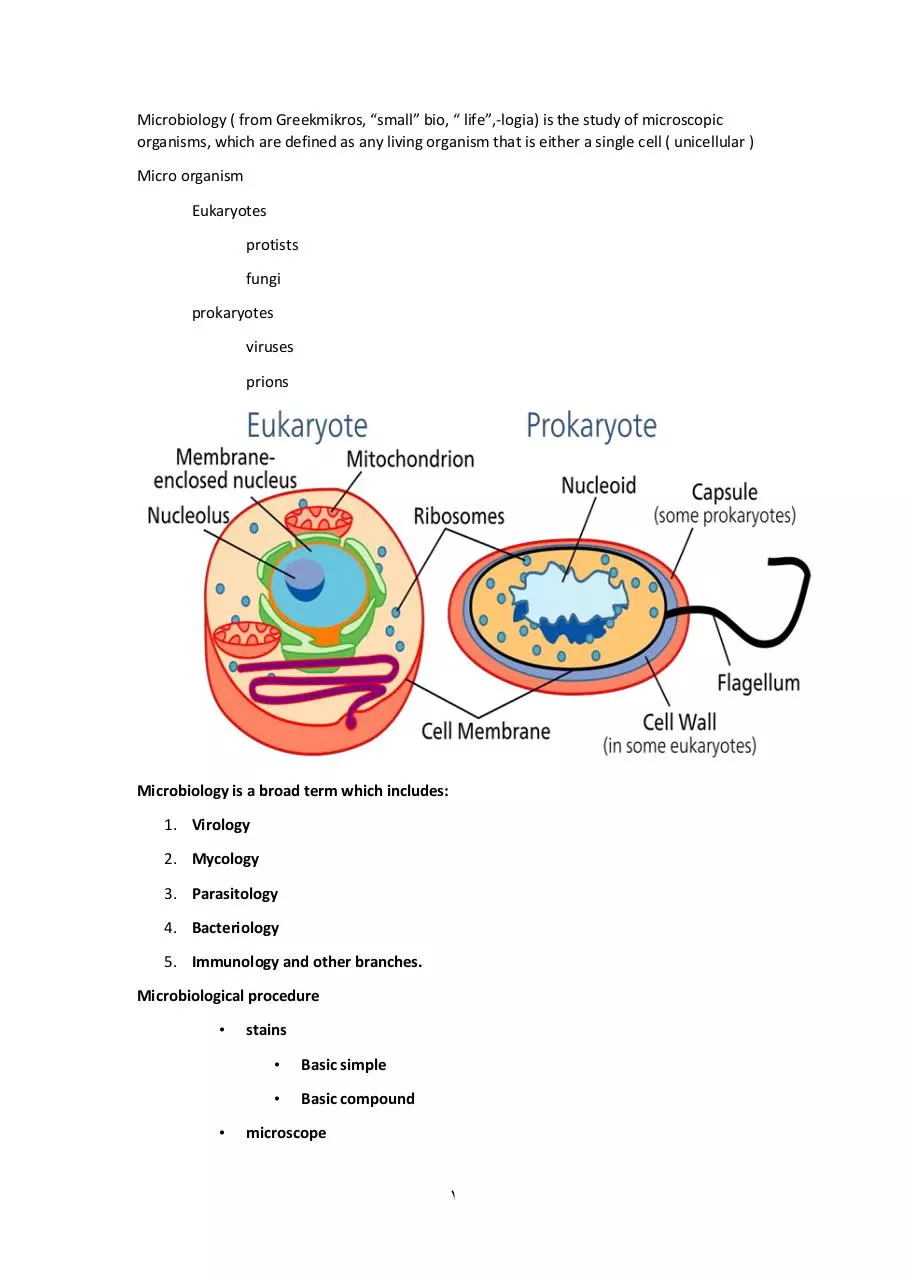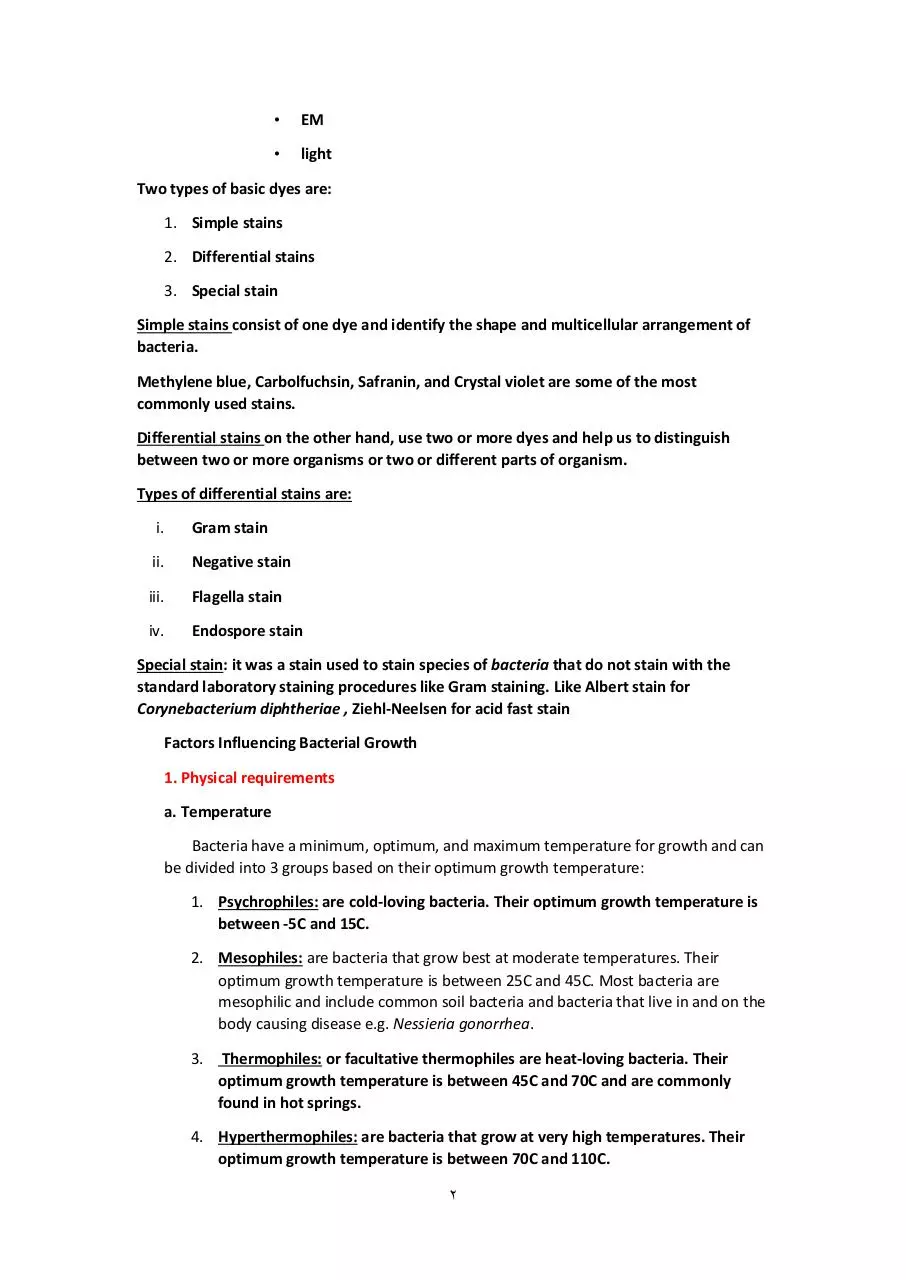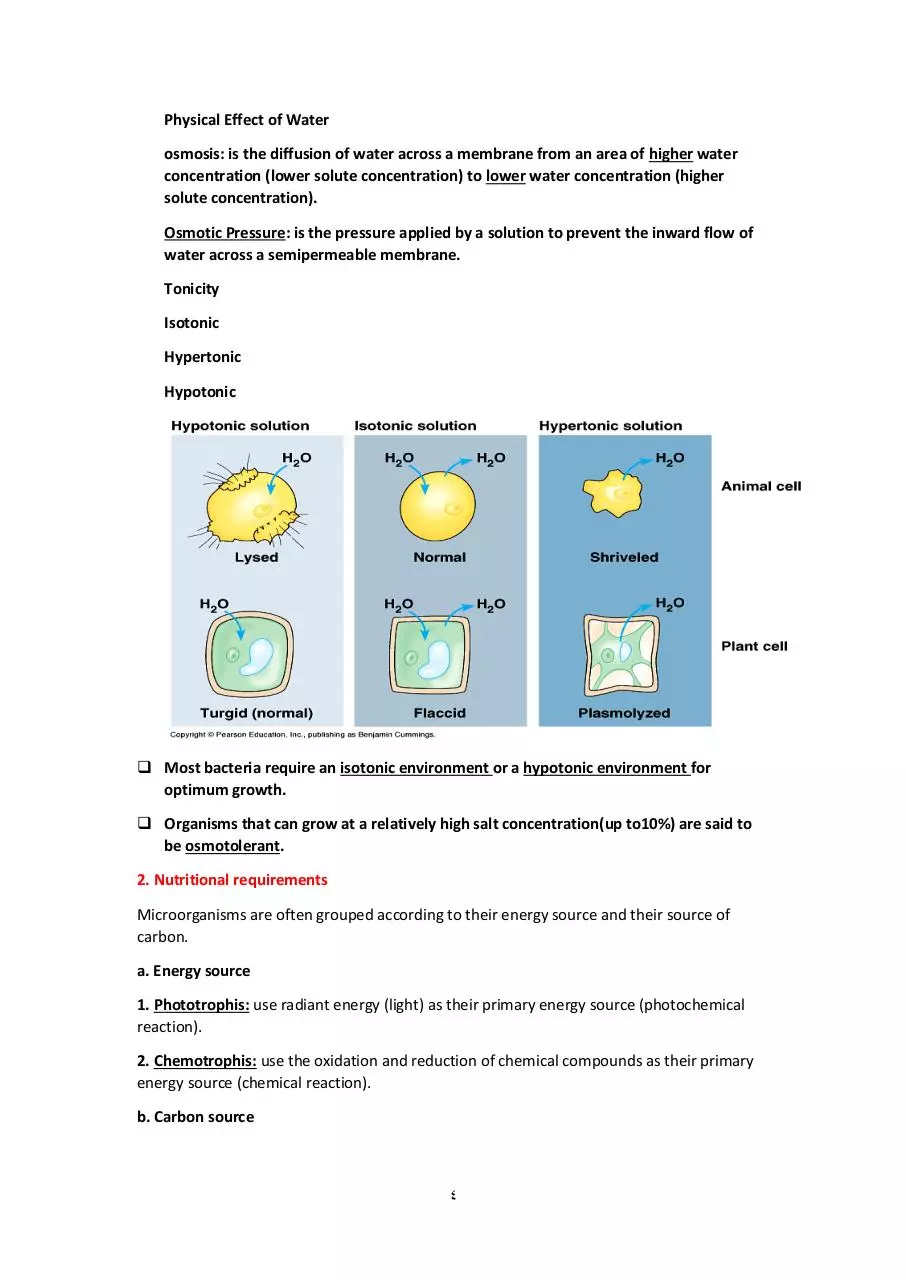lec1 (PDF)
File information
Title: Microbiology
Author: اØمد ÙŠØيى توÙيق
This PDF 1.5 document has been generated by Microsoft® Word 2016, and has been sent on pdf-archive.com on 16/11/2016 at 19:04, from IP address 5.1.x.x.
The current document download page has been viewed 563 times.
File size: 1.06 MB (9 pages).
Privacy: public file





File preview
MICROBIOLOGY
احمد يحيى توفيق
Microbiology ( from Greekmikros, “small” bio, “ life”,-logia) is the study of microscopic
organisms, which are defined as any living organism that is either a single cell ( unicellular )
Micro organism
Eukaryotes
protists
fungi
prokaryotes
viruses
prions
Microbiology is a broad term which includes:
1. Virology
2. Mycology
3. Parasitology
4. Bacteriology
5. Immunology and other branches.
Microbiological procedure
•
•
stains
•
Basic simple
•
Basic compound
microscope
1
•
EM
•
light
Two types of basic dyes are:
1. Simple stains
2. Differential stains
3. Special stain
Simple stains consist of one dye and identify the shape and multicellular arrangement of
bacteria.
Methylene blue, Carbolfuchsin, Safranin, and Crystal violet are some of the most
commonly used stains.
Differential stains on the other hand, use two or more dyes and help us to distinguish
between two or more organisms or two or different parts of organism.
Types of differential stains are:
i.
Gram stain
ii.
Negative stain
iii.
Flagella stain
iv.
Endospore stain
Special stain: it was a stain used to stain species of bacteria that do not stain with the
standard laboratory staining procedures like Gram staining. Like Albert stain for
Corynebacterium diphtheriae , Ziehl-Neelsen for acid fast stain
Factors Influencing Bacterial Growth
1. Physical requirements
a. Temperature
Bacteria have a minimum, optimum, and maximum temperature for growth and can
be divided into 3 groups based on their optimum growth temperature:
1. Psychrophiles: are cold-loving bacteria. Their optimum growth temperature is
between -5C and 15C.
2. Mesophiles: are bacteria that grow best at moderate temperatures. Their
optimum growth temperature is between 25C and 45C. Most bacteria are
mesophilic and include common soil bacteria and bacteria that live in and on the
body causing disease e.g. Nessieria gonorrhea.
3.
Thermophiles: or facultative thermophiles are heat-loving bacteria. Their
optimum growth temperature is between 45C and 70C and are commonly
found in hot springs.
4. Hyperthermophiles: are bacteria that grow at very high temperatures. Their
optimum growth temperature is between 70C and 110C.
2
b.Oxygen requirements
Microorganisms show a great deal of variation in their requirements for gaseous oxygen.
Most can be placed in one of the following groups:
1. Obligate aerobes (aerobic): are organisms that grow only in the presence of oxygen.
They obtain their energy through aerobic respiration. They require O2 as a hydrogen
acceptor e.g. Pseudomonadaceae, Bacillus, nitrobacter,---. Aerobic bacteria use
oxygen to break down pyruvic acid, releasing much more ATP than is produced
during glycolysis during the process known as aerobic respiration.
2. Microaerophiles: are organisms that require a low concentration of oxygen (2% to
10%) for growth, but higher concentrations are inhibitory. They obtain their energy
through aerobic respiration.
3. Obligate anaerobes: are organisms that grow only in the absence of oxygen and, in
fact, are often inhibited or killed by its presence. They obtain their energy through
anaerobic respiration or fermentation.
4. Aerotolerant anaerobes: like obligate anaerobes, cannot use oxygen to transform
energy but can grow in its presence. They obtain energy only by fermentation and
are known as obligate fermenters.
5. Facultative anaerobes: are organisms that grow with or without oxygen, but
generally better with oxygen. They obtain their energy through aerobic respiration
if oxygen is present, but use fermentation or anaerobic respiration if it is absent.
c. pH
Microorganisms can be placed in one of the following groups based on their
optimum pH requirements:
1. Neutrophiles grow best at a pH range of 5 to 8 (most pathogenic bacteria are within
this group).
2. Acidophiles grow best at a pH below 5.5 e.g. lactobacillus.
3. Alkaliphiles grow best at a pH above 8.5Vibrio cholera.
3
Physical Effect of Water
osmosis: is the diffusion of water across a membrane from an area of higher water
concentration (lower solute concentration) to lower water concentration (higher
solute concentration).
Osmotic Pressure: is the pressure applied by a solution to prevent the inward flow of
water across a semipermeable membrane.
Tonicity
Isotonic
Hypertonic
Hypotonic
Most bacteria require an isotonic environment or a hypotonic environment for
optimum growth.
Organisms that can grow at a relatively high salt concentration(up to10%) are said to
be osmotolerant.
2. Nutritional requirements
Microorganisms are often grouped according to their energy source and their source of
carbon.
a. Energy source
1. Phototrophis: use radiant energy (light) as their primary energy source (photochemical
reaction).
2. Chemotrophis: use the oxidation and reduction of chemical compounds as their primary
energy source (chemical reaction).
b. Carbon source
4
Carbon is the structural backbone of the organic compounds that make up a living
cell. Based on their source of carbon bacteria can be classified as autotrophs or
heterotrophs.
1. Autotrophis: require only carbon dioxide as a carbon source.
2. Heterotrophis: require organic forms of carbon.
Phosphorus: Phosphorus is needed to synthesize phospholipids, DNA, RNA, and ATP.
Phosphate ions are the primary source of phosphorus.
Potassium, magnesium, and calcium: These are required for certain enzymes to
function as well as additional functions.
Iron:Iron is a part of certain enzymes.
Trace elements: Trace elements are elements required in very minute amounts, and
like potassium, magnesium, calcium, and iron, they usually function as cofactors in
enzyme reactions. They include sodium, zinc, copper, molybdenum, manganese, and
cobalt ions.
Water
Growth factors
Growth factors are organic compounds such as amino acids, purines, pyrimidines,
and vitamins that a cell must have for growth but cannot synthesize itself.
Size of bacteria: Most bacteria are so small that their size is measured in units called
micron. The unit of measurement is the micro-meter, written m
Bacterial Nomenclature (Name of bacteria): Bacteria classify under the national taxonomy
like an other microorganisms by :
•
KingdomPhylum ClassOrderFamilies GenusSpecies
a. Types OR
b. Strain OR
c. Varieties.
And the name of bacteria writes according to:
•
Genous name species name …..
e.g. Salmonella typhi
Salmonella typhi
Salmonella paratyphi A
Salmonella paratyphi A
Salmonella paratyphi B
Salmonella paratyphi B
Structure of bacteria: - representation of a bacterial cell showing some of the essential
constituents
1. The cytoplasmic membrane consists of a layer of lipoprotein and is 5-10 nm thick. It
encloses the Cytoplasm
2. The cell wall is complicated lattice structure of lipoprotein, lipopolysaccharide and
peptidoglycan, which gives the bacterial cell its shape and also protects the cytoplasmic
membrane
5
3. Capsule: The cell wall of certain bacteria is covered with a capsule, which is usually a
loosely attached slime layer consisting of polymerized sugars and amino sugars that are
secreted by the organism. In many cases, possession of a capsule correlates with virulence.
4. Cytoplasm, which contains soluble metabolites and precursors of macromolecules
together
•
a) with organelles such as ribosomes. Lying within the cytoplasm is the bacterial
chromosome-usually a single
•
b) closed ring of double-stranded DNA . At binary fission a duplicate copy of the
chromosome passes to the new cell
•
c) circles of DNA, called plasmids, which often carry genes that confer antibiotic
resistance on the cells carrying them. Of greater current interest is the fact that
these plasmids may be transferred between cells of different type (e.g. nonpathogen
to pathogen).
5. Smaller pili (common pili of funbriae) are often found on bacterial cells. These may be
important in the attachment of pathogens to host tissue cells
6. Motile organisms possess flagella, which are thread-like appendages composed of protein
called flagellin, and are about 20 nm thick. Their rotation enables bacteria to travel at speeds
of up to 50 um per s. some organisms possess one flagellum, others more than one. The
arrangement of the flagella mono,lopho,amphi,peri-trichous and atrichous(no flagella)
Morphology of bacteria
Bacterial shape:
Bacteria can be classified into the following types according to their shape of the cells:
cocci
bacilli
Curved or comma
6
Spiral and coil
•
After binary fission the daughter cell remains attached to the parent cell and
fission occurs again before separates so the bacterial can be classified due to their
shape and aggregation and arrangement to:
1. Cocci (coccus) (0.5-1 m diameter):
a. Single like Micrococcus.
b. Pairs like Diplococcus.
7
c. Chains like Streptococcus
d. Groups of four (tetra) like Peptococcustetracocci.
e. Groups of eight (cubical paekat) like Sarcina.
f. Clustars (random clumps) like Staphylococcus.
2.Kidney shape like Neisseria.
3. Cocco-bacilli like brucilla.
4. Rod or cylinder (1-10 m length 0.2-1 m width):
i. Bacilli(bacillus):
a. Single Salmonella
b. Pairs Diplobacilli.
c. Chains Streptobacillus.
ii. Chinese latter Corynebacterium.
iii. Group of cigarettes Mycobacterium
iiii. With curved end (pole) E. coli.
iiiii. Cuneiform bundle Mycobacterium With or with out spores
5. Comma shape (curved)( 4m length -0.5m width)
single
pairs
Vibrio
small chains
8
Download lec1
lec1.pdf (PDF, 1.06 MB)
Download PDF
Share this file on social networks
Link to this page
Permanent link
Use the permanent link to the download page to share your document on Facebook, Twitter, LinkedIn, or directly with a contact by e-Mail, Messenger, Whatsapp, Line..
Short link
Use the short link to share your document on Twitter or by text message (SMS)
HTML Code
Copy the following HTML code to share your document on a Website or Blog
QR Code to this page

This file has been shared publicly by a user of PDF Archive.
Document ID: 0000508172.